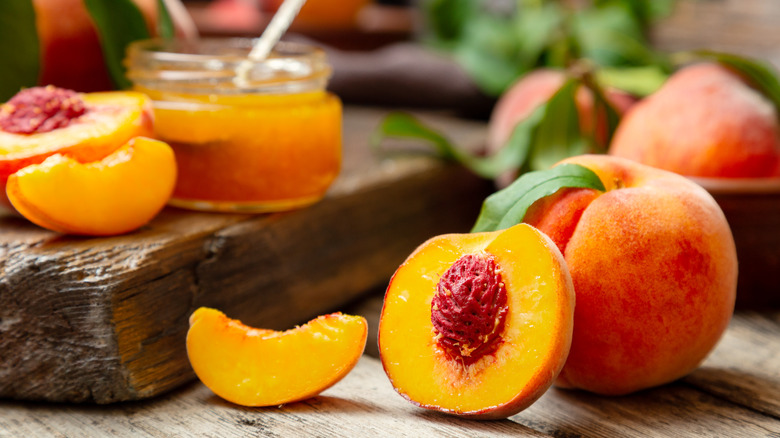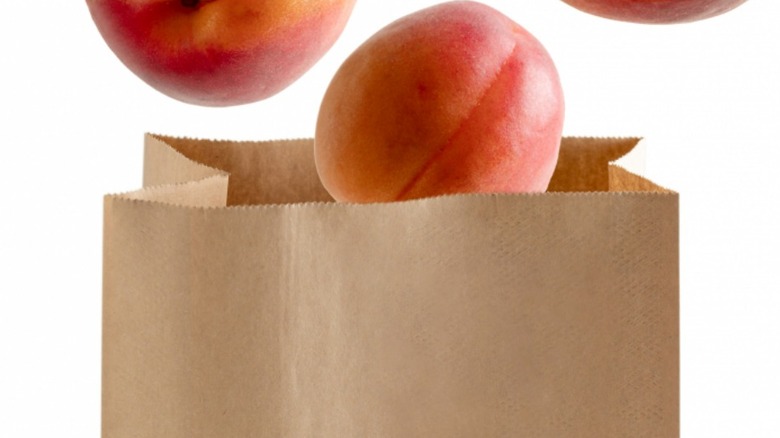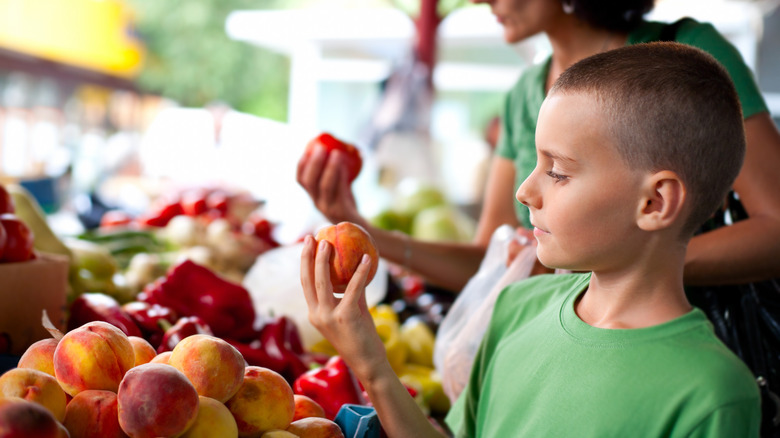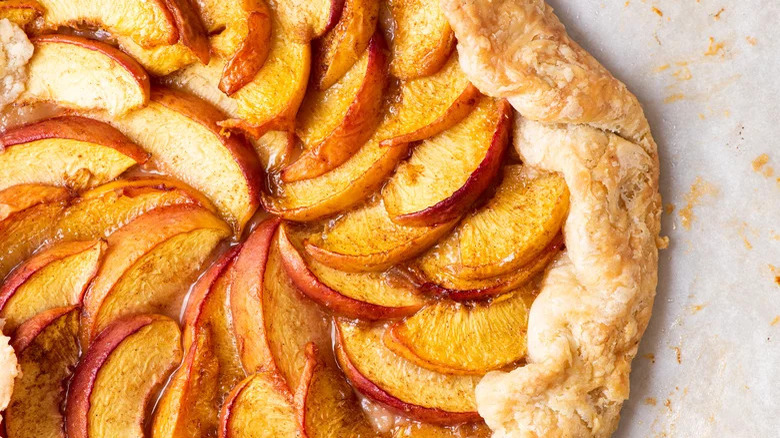How To Quickly Ripen A Peach
Sinking your teeth into a perfectly ripened peach is a revelation of sorts. The meltingly sweet flesh offers just the slightest hint of tang and yields smoothly to release rivulets of juices — making napkins a sensible, albeit optional, accouterment. Yet the peach, once among the three favorite fruits in the U.S., has been declining in popularity for decades. As of 2021, Statista had it ranked ninth. Colorado State University's Food Source Information attributes this relative loss of mojo to a number of factors, including a lack of knowledge on the part of consumers regarding how to select the best and ripest peaches and how to handle and store them for optimal results.
Indeed, the cards are stacked against the consumer because peaches ripen best when allowed to do so on the tree, and yet most commercially available peaches are picked before they're fully ripe. Some are even picked before the skin around the stem has had the opportunity to transform from green to yellow; and these will never ripen optimally, according to K-State Research and Extension Horticulture Newsletter. Other than the green ones, however, peaches will continue to ripen even after they've been picked. It's just a matter of how long the process may take.
The process takes longest when peaches are stored in the cold, such as in your refrigerator. It's faster to let your peaches ripen at room temperature. It's faster still and more effective if you've got the following tricks up your sleeve.
The paper bag method for accelerated peach ripening
If you put a single peach in a paper bag, fold the bag closed, and let it sit at room temperature, it should ripen to perfection within two days, if not sooner. That's because when peaches ripen, they release ethylene gas, which is a byproduct of fruit ripening as well as a fruit-ripening stimulant. The bag helps keeps the gas present and close at hand, and the paper is porous enough to allow for airflow. Plastic bags are not recommended for this purpose or for storing peaches in general, according to the Center for Agriculture, Food, and the Environment at UMass Amherst.
You can hasten the ripening process further by adding more peaches to the bag (for a higher relative ethylene gas volume). You can also add a different fruit to the bag, as long as it's a "climacteric fruit," which peaches are, and which refers to fruits that continue ripening off the tree. Apples, avocados, and bananas are climacteric fruits. Strawberries, cherries, grapes, and citrus fruits such as oranges are not.
Because peaches bruise easily, you'll want to handle them with care. That means laying them, stem-side down, in a single layer inside the bag, but with space between them so that they don't come into direct contact with one another. And when you check them for ripeness, you'll want to do so gently to avoid bruising. We'll get into how to tell if a peach is ripe in just a bit.
Use sunlight to quickly get peaches over the hump
If you leave your not-yet-ripe peaches out in the open on your countertop, they will ripen, albeit not as quickly as they would using the paper bag method. The same careful handling guidelines apply to peaches left on the countertop (i.e., stand the peaches on their stem-side "shoulders," in a single layer, not touching, with space in between, and avoid excessive handling in order to minimize bruising). But if your peaches are "this close" to optimal ripeness, you may be able to accelerate that final mile of the ripening process by placing them on a sunny windowsill — again, using the careful handling guidelines discussed above.
One drawback of finishing the ripening process in this manner, however, is that may attract fruit flies. Of course, that's an easy fix, since fruit flies are no match for our "apple cider vinegar cure." Another potential downside is that direct sunlight can quickly cause your peaches to overheat and shrivel. Accordingly, it's best to expose your peaches to sunlight for a matter of minutes, rather than days. Moreover, the windowsill method is best deployed when you are present and able to pay attention to the peaches' progress.
How to tell if a peach is ripe
If you're picking your own peaches, you'll first want to eliminate any with green around the stem. As discussed, these won't ripen fully even under the best of circumstances. Then pick only the ones that come away from the branch easily. You'll also want to make sure to select only those whose flesh offers a bit of give under gentle pressure. And by gentle pressure, we don't mean poking with a finger or squeezing it in your palm. Rather, it's better to simply hold the peach in your hand — gently, without pressing in with your fingertips, according to Red Wagon Farm. You'll still be able to tell if the peach feels soft — which is the goal — without the risk of bruising the flesh.
In addition, peaches become rounder as they ripen. You'll be able to see that roundness as well as feel it in your hand. Further, ripe peaches give off a telltale peachy aroma. In terms of color, you'll want to look for dark yellow; red isn't necessary. Although many peaches will have reddened skin, it's not actually a sign of ripeness.
When testing your peaches for ripeness at home, you can and should use all of these litmus tests. By contrast, if you're purchasing your peaches at a store, you can ignore all but the advice against green peaches, unless your intention is to consume them immediately.
What to bake with your perfectly ripe peaches
Now that you've got your hands on some sweet and juicy, perfectly ripe peaches, you'll want to make the most of your bounty. To show off how well you've handled and ripened your fresh peaches, consider using at least a few of them in this peach galette recipe, which requires only seven ingredients, and most of those are for the pastry crust. With only cinnamon and sugar to enhance the flavor of your fresh peach slices, their flavors and aromas will truly shine through.
Another seven-ingredient wonder, this classic peach cobbler recipe will also highlight your beautifully ripened peaches. This recipe is just a hint richer and sweeter than the galette, thanks to its cobbler-appropriate use of sugar and tapioca. It also has the advantage of taking significantly less time to prep.
The one thing you'll want to consider before slicing into that first peach, however, is that as soon as you cut into it, its flesh will begin to turn brown — just like apples and bananas and other climacteric fruits. If you decide to prep your peach slices in advance, you'll want to brush them with a tablespoon of lemon juice diluted in a cup of cold water. Uncut ripe peaches will keep in the fridge for up to five days. If you're heading toward five days and don't think you'll use them all, feel free to pop them in the freezer. Ripe peaches freeze surprisingly well!




